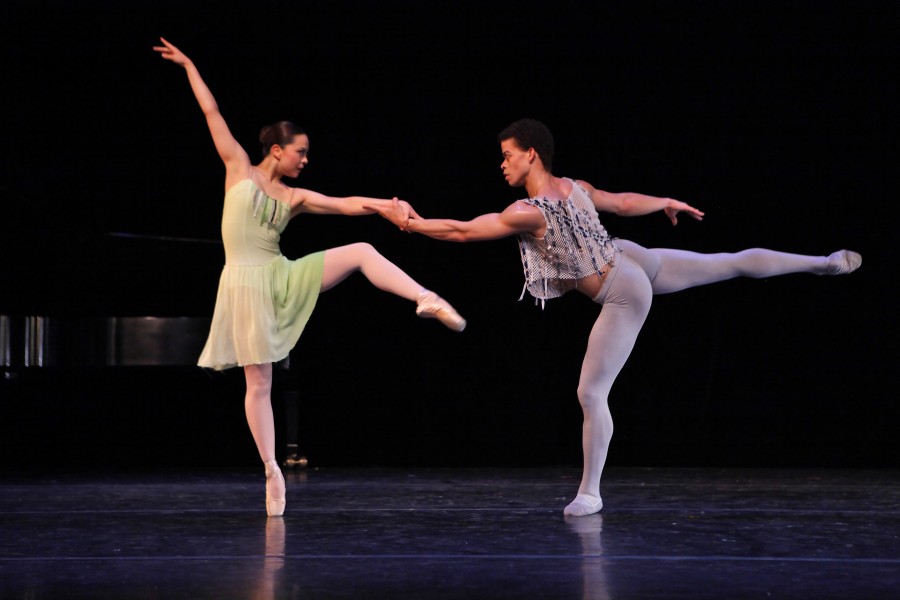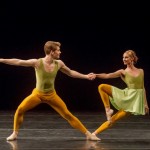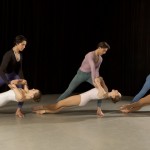
New York Theatre Ballet dancers demonstrate one form of trust in Merce Cunningham’s ‘Septet’. Photo: Richard Termine.
After watching a video clip that I had posted earlier of the elegant Aurélie Dupont and Manuel Legris, a dance student – who admits to a fear of partnering work – wrote to ask if I would post more examples of great partnering.
Happy to oblige, I selected clips from four iconic ballets that make a wide range of demands on partnering couples.
Start with Jirí Kylián’s witty 1991 commentary on the social construction of gender, Petite Mort (that’s the French ballet term for ‘orgasm’). This visually striking piece veers from a light-hearted silliness to a dark, almost sinister cynicism. The partnering work includes the more conventional hands-under-the-armpit lifts, as well as supported moves closer to the floor, and the woman bracing herself against the man’s thigh.
The central pas de deux in Alvin Ailey’s Revelations, expresses the prayer of a devout woman seeking solace from a figure who might be her minister or guardian angel. While he hovers closely over the woman, the man rarely touches her with his hands – unusual in partnering work. He lifts her by slipping his outstretched arms underneath hers, and supports her with his chest as she falls backward. She never appears to see him, nor is she even aware of his physical presence. Her trust in him, however, is absolute, as illustrated by the most striking supported movement (at 2:11): he places his fist behind her neck and lowers her to the ground, then draws her up again. She must have superb control of her back and abdominal muscles throughout. Of all the couples who’ve danced this since its premiere in 1960, April Berry and Kevin Brown are perhaps the most arresting.
Next up is the 5th movement of Paul Taylor’s crowd-pleasing Esplanade, a dance that contains no formal dance movements – said to have been inspired by the sight of a girl running to catch a bus. This plotless piece seems to fill audiences with inexplicable joy, possibly a reaction to the sheer musicality of all the mad dashing and tumbling. The bravura partnering section starts at 2:50 with a series of backward falls in which the man catches the girl, but doesn’t hold on to her, just slows down her fall. She rolls onto the floor and stands up, only to fall back again; he is doing his darndest to run away from this nutty girl but here she comes again, relentlessly falling backward, and he must be in position to catch her once more. The timing and the split-second distance calculation involved remind us of a shortstop executing a perfect double play.
Then at 4:08 a series of spectacular jumps in which the girls hurl themselves into the air and land in the boys’ arms. It is perhaps the most pedestrian of partnered jumps, requiring no formal technique, just brute strength, exquisite timing and nerves of steel.
At this point, I should reassure Olivia that she will not walk into her first partnering class and immediately be asked to hurl herself into the air! Partnering class is usually very structured, and begins with basic exercises that require the gentlemen to get the ladies on their balance – first on two feet (in sous-sus, for example) then on one foot (in arabesque piqué, for example). The boy will first hold onto her waist with two hands, then switch to two hands holding on to her two hands, then single-handed support, gradually increasing the distance between the partners’ centres of gravity, which makes the work harder. My favorite exercise has the ballerina standing in sous-sus while she falls from side to side, her partner lunging to bring her back to her balance each time.
Jerome Robbins explored the art of classical partnering in the brilliant Dances at a Gathering with a simplicity and naturalness that hints at deep underlying joys, passions, and regrets. In this rehearsal segment of a spin-off called Three Chopin Dances, a moody but tenderly attentive Joaquin de Luz, coached by Damian Woetzel, pushes Tiler Peck gently off her balance in various directions starting at 1:55, pulling her back onto her balance each time.
Peck radiates delight throughout the dance, as if to say “Aren’t I the luckiest girl in the world to be dancing with this amazing guy?”
This is also a good strategy for managing a relationship with one’s partner: behave as if you are thrilled to be dancing with him, and it will be easier to work out the rough spots and the things you want him to change.

Rie Ogura & Steven Melendez of New York Theatre Ballet supporting each other in Richard Alston’s ‘A Rugged Flourish’, set to Aaron Copland’s Piano Variations. Photo: Richard Termine.
Once the gentleman has mastered getting the ballerina on her balance on one leg, they can move on to promenades, then pirouettes, and finally lifts. Promenades can often be more challenging than many spectacular looking lifts, because they require so much control and stability on the girl’s part. In a promenade, the girl must step into her position then maintain the shape squarely, allowing the boy to do the work of rotating her around on her pointe. Lots of adage work is key to being able to balance on one leg and hold extensions at the proper height in promenade.
Overhead lifts are usually practiced for the first few times with a spotter. And before doing them standing up you will often practice the shape of the lift with the man lying on his back on the floor, so if the ballerina falls she is never more than a foot from the ground. The strength and timing of the ballerina’s jump, and her back strength, are critical to the success of a lift. All a girl’s preparations should take slightly longer than if she were jumping alone, because she has to allow that split-second for the boy to react.

Jay Franke & Griff Braun in Lar Lubovitch’s ‘Concerto Six Twenty-Two’, set to Mozart’s Concerto for Clarinet & Orchestra. Premiered in 1986, it became a kind of anthem in the fight against AIDS. Photo: New York Times.
Ballet to the People recalls a series of rehearsals, many years ago, for a pas de deux featuring an overhead lift into cambré derrière, similar to the one at 2:20 in the Chopin Dances clip above. It was straightforward, simply requiring a straight-up jump into a backward arch, and it was a two-hander, so no big deal… All he had to do was plié, get under her and push straight up, then lock his elbows at the top. Except that B2TP and her partner were not well matched heightwise (she was 5’2” and he was 6’) so her jump had to be exceptionally strong, her flight path seemed so long that she half-expected a stewardess to show up offering snacks – and she could not escape the fear, as she watched the fluorescent-lighted ceiling approach, that she would continue to sail backward and fall on her head.
Her partner had only been dancing for a year; he had given up college football for ballet. That he was very good at tackling big men and throwing them to the ground was not a great comfort. In rehearsal, the lift worked about two-thirds of the time; when it failed he always positioned himself underneath her to cushion her fall. There were no mishaps in performance. 28 years later, they are still married.








So interesting, well thought out and well explained. Such an interesting read! Now, to go back and watch the videos!
Thanks for writing this post! I love the Chopin Dances video, Tiler Peck is so beautiful in it. I like the way she dances with her upper body a lot, not just her legs. My teacher keeps saying that ballet is not just legs legs legs and you can understand that when you see someone like Tiler Peck dance.
Actually, I think I’m strong enough for pas de deux class but I’m anxious about some of the boys that I might be partnered with. I know you can’t ask the teacher to pair you up with someone who makes you feel safe. I just don’t think they’re all strong enough. I’m pretty short (5’1″) so I know I will get put with the shorter guys, but I am not light, so I’m going to be hard to lift. The boys are supposed to be doing strength and conditioning but I can’t tell if it’s doing any good. Some of them are really skinny and look like they need a Philly cheese steak. Or two.
Olivia, Sounds like some of those boys may be going through their growth spurt. It takes a little while for muscle development to keep up with bone growth when teenagers have their growth spurts. Your teacher will know what is safe, will not put boys in class who are not ready to start partnering, and she/he will pair students up not just by height, but by weight as well.
Sometimes, though, there are simply not enough boys to go around in class, and you end up with a less than ideal match – in which case you just have to make the best of it and hang on to your sense of humour. I’m sure you will not be asked to do anything that is outright dangerous, but there is always the chance of being yanked off balance and spraining an ankle, or something like that – but these are injuries you risk even without a partner.
You should understand, though, that the girl’s weight is not necessarily the biggest factor in successful lifting – most boys would rather partner a heavier girl who can really jump and hold her back up, than a light one with a weaker jump and floppy back.
In her excellent book, Off Balance: The Real World of Ballet, Suzanne Gordon quoted dancer Vane Vest, who was known to be a fine partner, as saying: “I can make any woman look good… But… you partner a woman and lift her at the waist and you want to touch something. These skinny ballerinas, it’s awful. There’s nothing there. How can you do a pas de deux with one of those girls? Their bones become brittle… One of the most exciting experiences I’ve ever had is dancing with Cynthia Gregory. Cynthia is built like a woman. She’s not heavy, but there is a body there. She looks like a woman, but, goddam it, she looks like a ballerina, too. These other girls, they’re hideous. And it’s hideous that management condones this stuff and does nothing to stop it, because what they’re saying is that thin is good and that looking normal is bad.” (He was referring to excessive dieting and weight loss, of course.)
I think there is more consciousness today than in Vane Vest’s time about the need for girls to be healthy and strong. And there is no getting around the fact that boys have to be heavier and stronger themselves if they’re going to partner these girls. So let’s hope the boys in your class are doing their push ups and eating those Philly steaks.
Thanks for putting in so much time and thoughtful efforts. The little boy who asked you a favor must have been so pleased, as well as many others I’m sure. There really is so much to partnering and you did a great job in including it all. Beautiful job and thanks.
Regarding skinny wee lads: I have NOT done ballet partnering, but I have done Latin dance partnering, and I was startled to learn, as a fairly big tall woman, that men are… strong. Even lanky ones, even little short ones, had no trouble biffing me about the place. None of these guys were trained dancers and they had backgrounds as wide as labouring and office jobs, but they were ALL far stronger than I anticipated, and in fact some men obviously had no idea just how strong they were and were far too rough at times. Obviously some women are stronger than some men, and just being possessed of the right chromosomes and hormonal mix is not enough to do ballet partnering, but I would like to reassure Olivia that even those skinny guys are probably much stronger than you think.
Bystander,
I LOVE Latin partnering, it can look so fluid and breathtaking. I’m not sure what “biffing” is (is this a Latin dance term?) – but I’m guessing that, as a conscientious ballet teacher, if I saw a boy “biffing” a girl about, I might feel compelled to put a stop to it…!
You are right not to judge someone’s strength from their size. And so much of partnering is dependent on timing, not just brute strength alone.
The exception to this are the dead lifts, in which the girl can not help her partner with a jump. Which is why, in ballet at least, we do have weight guidelines for partnering – meaning that the boy needs to be a certain amount heavier than the girl if he is expected to lift her.
As a fellow football player/weightlifter/ballet dancer. There is a big difference between brute strength and a static hold. And are quite different. In most instances it would actually be much harder to brute force the lighter girl with the wimpy jump up and hold her than the heavier girl that actually gets all the way up and you give her some assistance and can concentrate more fully on actually holding the weight with your body in the optimal alignment (at least, that’s what you would do in olympic style weightlifting!)
The more complicated the lifting motion the more technique plays a part and that somewhat makes it easier to do over the long run than just getting bigger!
Philly cheese steaks are excellent bulking foods as well 😀
Tor, I wish you were in my partnering class. Some of these guys are rude and lazy, they complain and say how heavy the girls are when really they just don’t want to work at it that hard. I know ballet is oldfashioned, the guys have their job and the girls have THEIR job and they’re supposed to be polite to each other and all that but really sometimes I just want to give these guys a kick in the shins and say shut up drop and give me 50.
Though it has been a long day and I haven’t the energy for an eloquent comment, I have to say I am blown away by the beauty and power of this blog. And you, Carla, are an inspiration. Is there anything you haven’t done? I am so glad to have found you online!
Since I’m here, this is my two cents on pas de deux. It’s been a long time, but in my experience, when a girl (of any weight) holds herself strong and uses her plie, and when a boy focuses on the girl’s center and not on his reflection in the mirror, things usually work out ok. 🙂
Heartfelt thanks, Lisa.